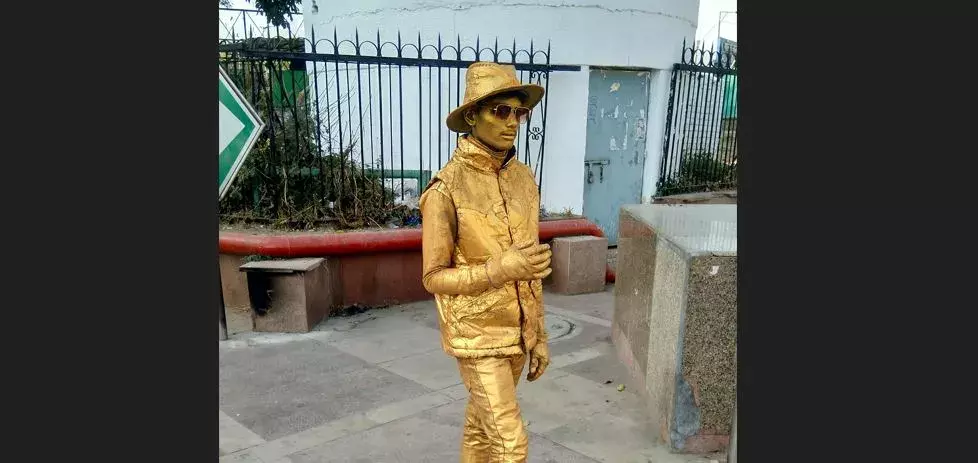Gold On The Road
The Golden Man can be seen at different points in Delhi’s CP;

Is it real or just a newly-erected statue on a New Delhi pavement? Perhaps a unique expression of public art by the municipal authorities. Many visitors to Connaught Place, the capital’s fashionable shopping centre hurry by scarcely glancing at the golden statue on the pavement. Some pass on after giving a curious look while just a few actually stop for a closer examination and even take pictures with him and put some money in the cardboard box kept nearby. One young man, more daring than others, actually touches the statue in the face to make sure and exclaims: “This is a live human, not a statue.”
A golden hat, golden face, golden hands, jacket, trousers and even golden shoes. That is what the golden man looks like as he stands still with one arm raised in the air just like in many prominent statues. It’s as if the story of Midas has come true. The man who stands without moving for long periods of time is Rajnesh who travels about 40 km every day from his home in West Delhi’s Najafgarh area to Rajiv Chowk on the Metro. His daily motionless act in the middle of a bustling shopping promenade appears to be something of an aberration in these days of that widespread phenomenon called ADHD (attention deficit hyperactivity disorder).
As far as statues go there aren’t any in the Connaught Place area and are more common about a couple of kilometres away near Parliament and the buildings that house government offices. Which is why a statue in Connaught Place is particularly noticeable.
The Golden Man stands either in the middle of the Central Park near its fountains or on a pavement just outside the underground shopping arcade, Palika Bazaar, or in the corner in front of Khadi Bhandar which sells handmade clothes and many other products of cottage industries or on the corner where Janpath meets the Connaught Circus.
Statues are usually carved out of durable materials like stone, wood or metals to impart longevity to the memory of prominent people. Lured by the promise of some kind of permanence though made of flesh and blood, Rajnesh stands in each pose from as much as five hours at a stretch. The disadvantage of solid stone statue in a public place is that their heads and shoulders provide a favourite perch for sundry birds which leave their droppings that have to be periodically scrubbed off.
Other drawbacks include the risk of being pulled down as changing times turn yesterday’s heroes into today’s villains. It could be the statues of people like Saddam Hussein of Iraq or Basher al Asad of Syria after their regimes were toppled. Or it could be that of a 17th Century British slave trader Edward Colston whose statue in Bristol, (England) erected in 1895 was pulled down by protestors from the Black Lives Matter movement. As one British historian put it, his statue was erected in the 19th Century to say ‘this was a great man and did great things’. With the passage of time, far from being regarded as great, men involved in human trafficking are despised.
But Rajnesh has no such fears since all he has to do if someone objects is to go stand someplace else. What made him opt for this strange profession? “I wanted to get out of the rut and do something that would make people happy,” he reveals. A small-time building contractor, he had always been interested in being an actor and even joined an acting academy in East Delhi. He even visited Bollywood to try his luck but his acting career failed to take off.
It was a few years back that the idea of enacting the role of a living statue occurred to him. All he had to do was to procure a can of golden paint spray and he was in business. Not much work of art unlike those in stone, metal or wood which demand considerable carving and creative skills from the sculptor. After all, Rajesh's facial and other features are god given and need not be worked upon.
But this is what John Eicke, master artist and two-time World Living Statue champion has to say: “The artist who acts as a living statue unites the fine arts (including costume design, special effects, makeup and props design and manufacture) with the performing arts such as choreography, illusion and interaction. A good living statue must be multi-talented and have an unprecedented artistic quality.”
Indeed, for over a decade a World Living Statues Festival (WLSF) has been held, starting with Arnhem, The Netherlands and spreading to other European countries.
The art of living statues came into vogue more than a hundred years back when stage actors took advantage of the English law that prohibited nudity on stage unless the performers remained perfectly motionless when the curtains were open. Some actors did this, calling it ‘plastic representation’ https://en.wikipedia.org/wiki/Living_statue.
A living statue appeared in a scene of the 1945 French film Les enfants du paradis (Children of Paradise). The London-based artists Gilbert and George created living statues in the 1960s. In India the idea was used in Dhoom 2 (2006) in which Hrithik Roshan posed as a human statue in a museum to rob a diamond.
As of now all three men who model as living statues in the Connaught Place area, have chosen to paint themselves golden. You’ve seen one, you have seen them all. The gold man who stands at the Janpath Crossing gave his name as Ravi Kishen (a coincidence?). A cobbler who sits nearby puts bigger denomination currency notes in the collection tray and takes away the change. The third gold man stands at the centre of Central Park. But they surely have to raise their standards and increase variety to compete at the international level.

